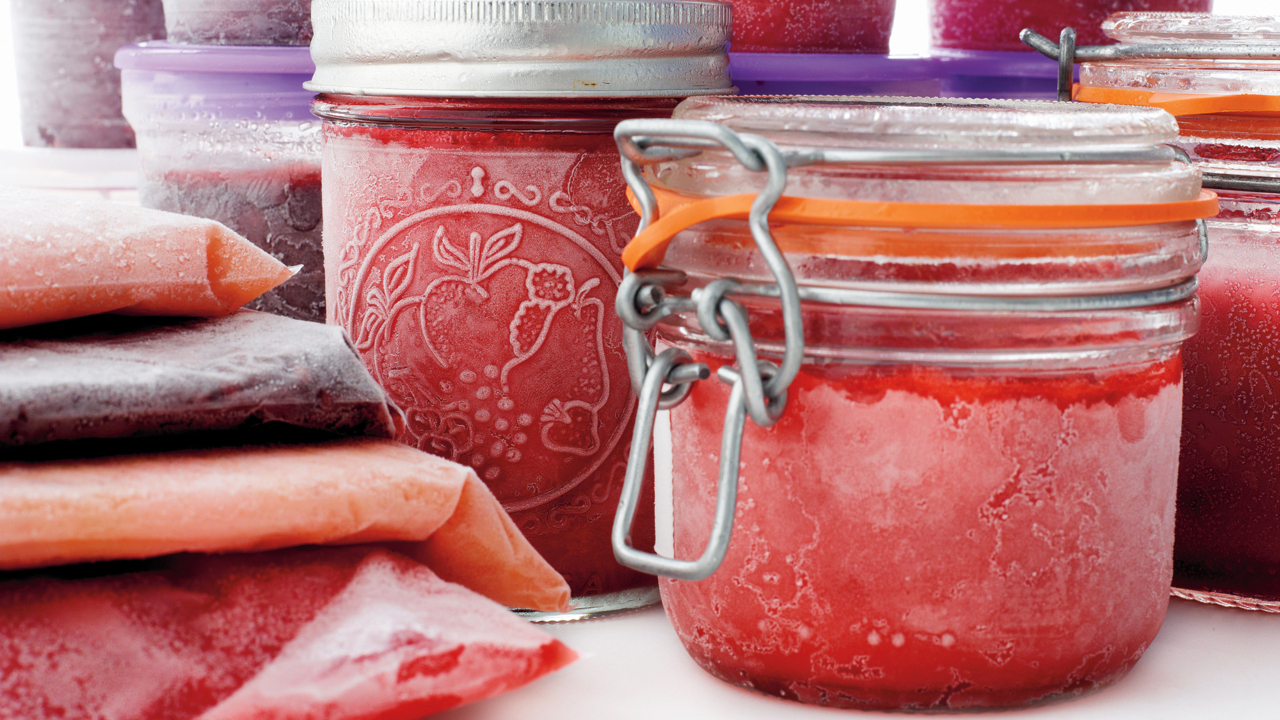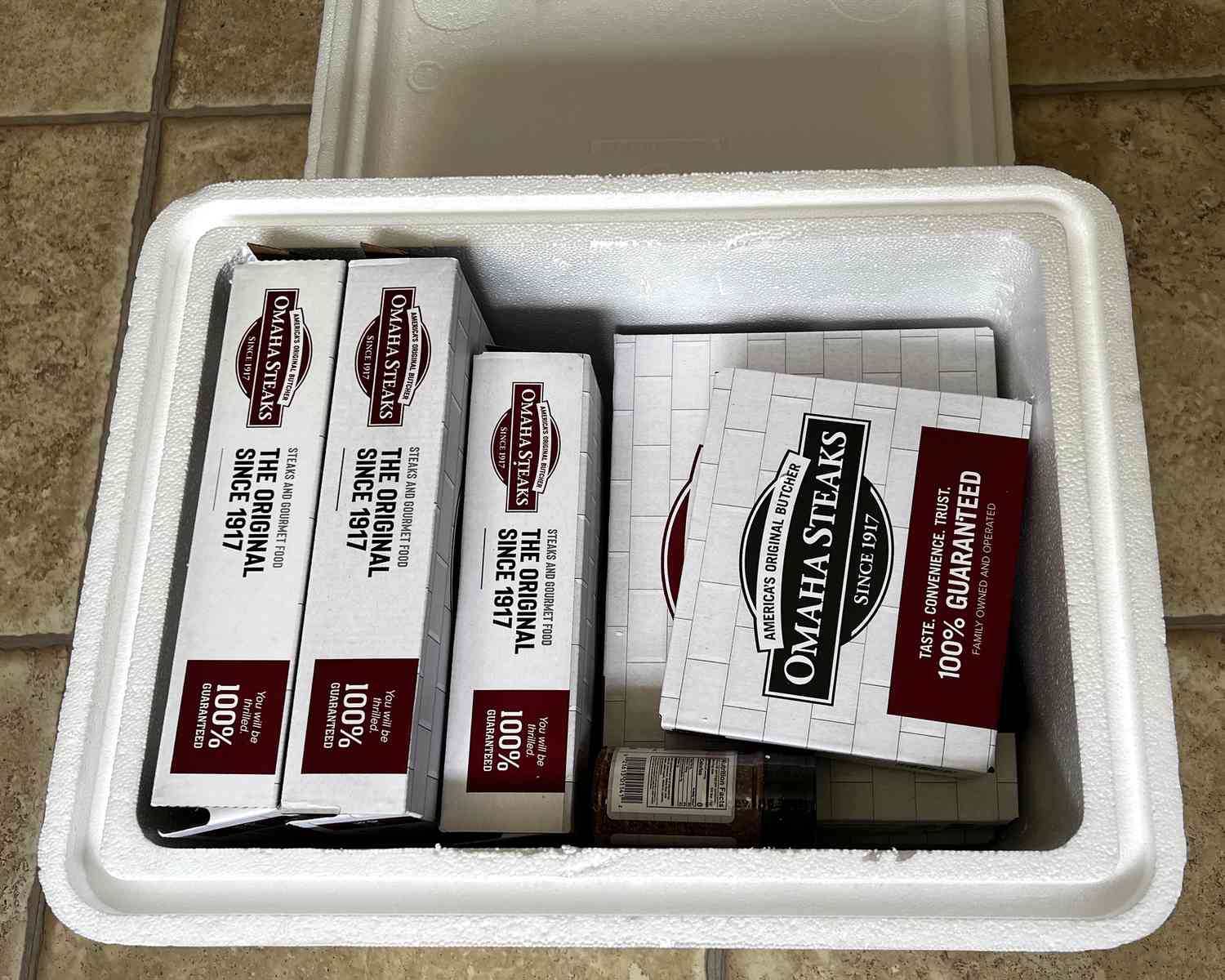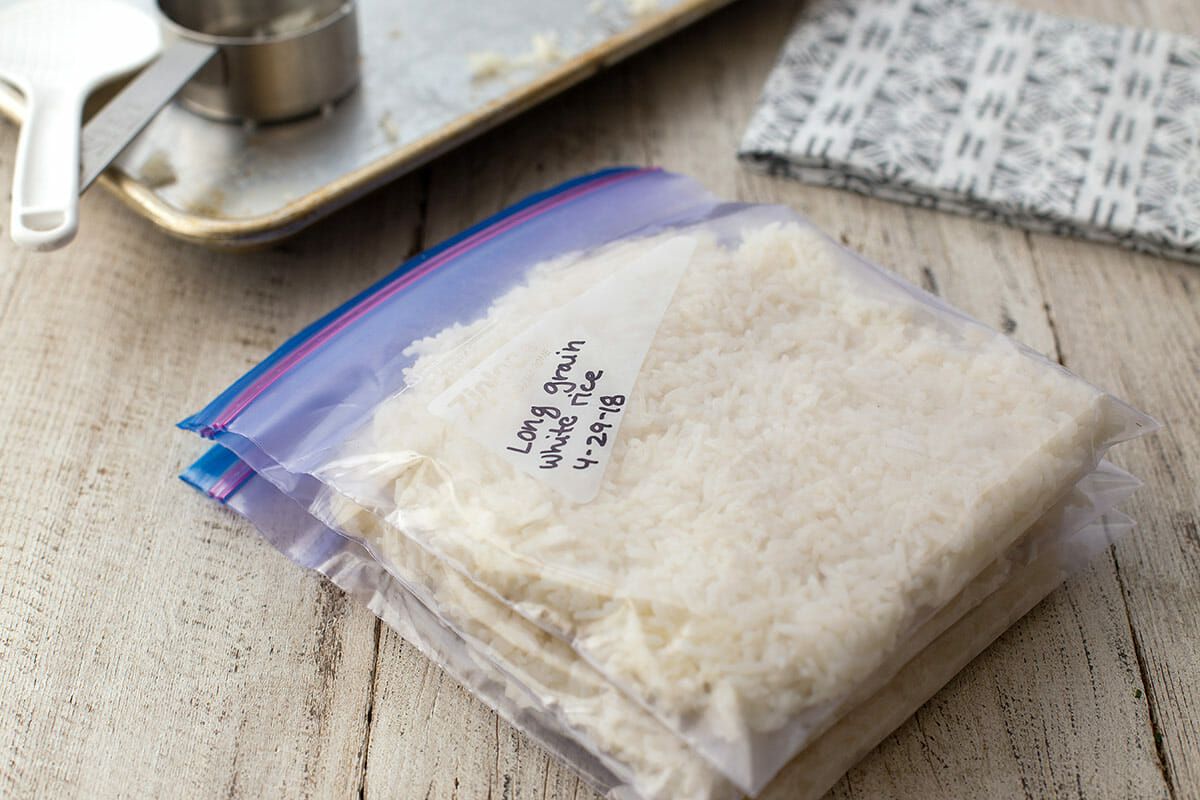

Articles
How Long Does Dry Ice Last In A Freezer
Modified: October 20, 2024
Discover all you need to know about the shelf life of dry ice in a freezer and get helpful tips on storing it for optimal use. Read more in our informative articles.
(Many of the links in this article redirect to a specific reviewed product. Your purchase of these products through affiliate links helps to generate commission for Storables.com, at no extra cost. Learn more)
Introduction
Dry ice is a fascinating substance that has many unique properties. It is formed when carbon dioxide gas is cooled and compressed, causing it to solidify into a block of ice-like material. Despite its name, dry ice does not actually melt like regular ice. Instead, it sublimates, meaning it converts directly from a solid to a gas without passing through a liquid state.
Due to its extremely low temperature (-78.5 degrees Celsius or -109.3 degrees Fahrenheit), dry ice has a wide range of applications, from scientific experiments to food preservation. In this article, we will explore the lifespan of dry ice in a freezer, as well as factors that can affect its longevity.
Key Takeaways:
- Dry ice can last 12-24 hours in a standard freezer, but factors like temperature, insulation, and frequency of door openings affect its lifespan. Optimizing these factors can extend the duration of dry ice and preserve items effectively.
- When handling dry ice, safety is paramount. Use protective gear, ensure proper ventilation, and follow disposal guidelines. By prioritizing safety and understanding key factors, you can harness the power of dry ice for effective freezing and preservation.
What is dry ice?
Dry ice is the solid form of carbon dioxide (CO2). It gets its name because it appears dry and has an ice-like texture, even though it is extremely cold and does not turn into liquid when it melts. Dry ice is made by pressurizing and cooling carbon dioxide gas until it reaches a temperature of -78.5 degrees Celsius (-109.3 degrees Fahrenheit).
Unlike regular ice made from water, dry ice does not melt into a liquid state. Instead, it undergoes a process called sublimation. This means that when dry ice is exposed to warmer temperatures, it directly transitions from a solid to a gas without passing through a liquid phase.
Dry ice is commonly used for a variety of purposes, including in transportation, food preservation, and scientific experiments. Its unique properties make it an effective coolant and a popular choice for freezing and preserving perishable items.
When handling dry ice, it is important to exercise caution. Direct contact with the skin can cause frostbite, and inhaling large amounts of carbon dioxide gas can lead to asphyxiation. Therefore, it is crucial to take the necessary safety precautions when working with dry ice.
How does dry ice work?
Dry ice works by utilizing its extremely low temperature to freeze and preserve items. When placed in a freezer, the cold temperature of dry ice creates an environment where heat is rapidly transferred away from the surrounding objects, causing them to freeze.
The key to dry ice’s effectiveness lies in its sublimation process. As dry ice is exposed to warmer temperatures, it undergoes sublimation, turning from a solid directly into a gas. This process releases large amounts of cold gas, which helps to maintain the low temperature within the freezer.
When dry ice sublimates, it creates a cloud of carbon dioxide gas. This gas is denser than air, so it tends to sink and displace oxygen. Therefore, it is important to ensure proper ventilation when using dry ice in a confined space to prevent the accumulation of carbon dioxide gas.
Since dry ice does not leave behind any residue when it sublimates, it is an ideal choice for situations where liquid residue from melting ice would be problematic. Additionally, dry ice is much colder than regular ice, making it more suitable for long-term storage and transportation of perishable items.
It is worth noting that the rate of sublimation can vary depending on several factors, such as the temperature of the freezer, the amount of dry ice used, and the insulation of the container. Understanding these factors is crucial for determining how long dry ice can last in a freezer.
How long can dry ice last in a freezer?
The duration that dry ice can last in a freezer varies depending on several factors. Generally, dry ice can last anywhere from 12 to 24 hours in a standard freezer. However, with proper insulation and temperature control, it may last longer.
The main factor affecting the lifespan of dry ice in a freezer is the temperature. The colder the freezer, the slower the sublimation process and the longer the dry ice will last. Most household freezers are set to around -18 degrees Celsius (0 degrees Fahrenheit), which is not as cold as the temperature at which dry ice is stored (-78.5 degrees Celsius or -109.3 degrees Fahrenheit). Therefore, some sublimation is expected even in a freezer.
Furthermore, the amount of dry ice used plays a role in determining its lifespan. The more dry ice you have, the longer it will last in the freezer. It is important to note that dry ice should be stored in a well-insulated container to maximize its longevity and minimize temperature fluctuations.
Additionally, how frequently the freezer is opened can impact the lifespan of dry ice. Each time the freezer door is opened, warm air enters, causing a rapid increase in temperature. This can speed up the sublimation process and reduce the duration that the dry ice remains solid. It is advisable to limit opening the freezer door unless necessary to preserve the dry ice for as long as possible.
Lastly, the insulation of the container or packaging that holds the dry ice can affect its lifespan. A well-insulated container will help maintain a lower temperature and slow down the sublimation process. Using a cooler or a container with thick walls and a tight seal can help extend the amount of time that dry ice remains frozen.
It is important to keep in mind that these estimations are general guidelines, and the actual duration may vary depending on the specific circumstances. Monitoring the dry ice’s state and taking the necessary precautions is key to ensuring its effectiveness in preserving items in the freezer.
Store dry ice in a well-insulated cooler or thickly insulated container in the freezer to make it last longer, typically around 18-24 hours.
Factors affecting the lifespan of dry ice in a freezer
Several factors can impact the duration that dry ice lasts in a freezer. Understanding these factors is crucial in optimizing the lifespan of the dry ice and ensuring its effectiveness in preserving items. Below are some key factors to consider:
- Temperature: The temperature of the freezer is one of the primary factors affecting the lifespan of dry ice. The colder the freezer, the slower the sublimation process and the longer the dry ice will last. While standard household freezers are typically set to around -18 degrees Celsius (0 degrees Fahrenheit), it is worth noting that dry ice is stored at a much colder temperature of -78.5 degrees Celsius (-109.3 degrees Fahrenheit).
- Amount of dry ice: The quantity of dry ice used in the freezer directly impacts its lifespan. More dry ice will take longer to sublimate and therefore last longer. If you have a large amount of items to preserve, using a sufficient amount of dry ice can help ensure optimal preservation for an extended period.
- Insulation: The quality of insulation surrounding the dry ice plays a significant role in its lifespan. A well-insulated container or packaging helps to maintain a lower temperature and slow down the sublimation process. Using a cooler or a container with thick walls and a tight seal can help extend the duration that the dry ice remains solid.
- Frequency of freezer door openings: Each time the freezer door is opened, warm air enters the freezer, causing a rapid increase in temperature. This temperature fluctuation accelerates the sublimation process. To maximize the lifespan of the dry ice, it is recommended to limit the opening of the freezer door to essential times only.
- Item placement: The placement of items in relation to the dry ice can affect its lifespan. It is advisable to keep the dry ice as close to the items that need to be preserved as possible. This ensures that any heat transfer occurs between the items and the dry ice, reducing the sublimation rate.
- Air circulation: Proper air circulation within the freezer can help maintain a more consistent temperature and slow down the sublimation process. Avoid overcrowding the freezer and ensure that there is enough space for air to circulate freely around the dry ice and the items being preserved.
By considering and managing these factors, you can optimize the lifespan of dry ice in a freezer and effectively preserve items for an extended period.
Read more: How Long Does Coffee Last In Freezer
Tips for optimizing the duration of dry ice in a freezer
When using dry ice to preserve items in a freezer, there are several tips you can follow to maximize its lifespan. By implementing these tips, you can ensure that the dry ice remains solid for a longer duration and effectively preserves your items. Here are some tips to optimize the duration of dry ice in a freezer:
- Pre-freeze the items: If possible, pre-freeze the items you plan to store in the freezer before adding the dry ice. This helps to reduce the amount of heat transfer between the items and the dry ice, thus slowing down the sublimation process.
- Use sufficient amounts of dry ice: Ensure that you have enough dry ice to fill the freezer adequately. A larger quantity of dry ice takes longer to sublimate, prolonging its lifespan. Use a scale to measure the correct amount of dry ice based on the size and volume of the freezer.
- Insulate the dry ice: Proper insulation is crucial in maintaining a lower temperature and slowing down the sublimation process. Wrap the dry ice with layers of newspaper or place it in an insulated cooler to provide additional insulation and prevent rapid temperature fluctuations.
- Keep the freezer door closed: Limit the number of times you open the freezer door to prevent warm air from entering and causing temperature fluctuations. Create a plan to retrieve or place items in batches, minimizing the duration that the freezer door is open. This helps to preserve the cold temperature inside the freezer and prolong the lifespan of the dry ice.
- Store the dry ice on top: If possible, place the dry ice on top of the items in the freezer. This allows the cold air from the sublimating dry ice to flow down and surround the items, creating optimal cooling conditions and reducing the sublimation rate.
- Monitor the temperature: Use a thermometer to regularly monitor the temperature inside the freezer. Ensure that it remains within the optimal range for dry ice storage (-78.5 degrees Celsius or -109.3 degrees Fahrenheit). If necessary, adjust the temperature settings to maintain the ideal conditions.
- Use insulated containers: If you have smaller items that need to be preserved, consider using insulated containers or coolers within the freezer. These containers provide an extra layer of insulation and minimize heat transfer, helping to extend the lifespan of the dry ice.
By following these tips, you can optimize the duration of dry ice in a freezer and preserve your items effectively. Remember to always prioritize safety measures when handling dry ice and ensure proper ventilation in the storage area to prevent the accumulation of carbon dioxide gas.
Safety precautions when handling dry ice in a freezer
While dry ice is a useful and versatile substance, it is essential to take proper safety precautions when handling it, especially when using it in a freezer. By following these safety guidelines, you can ensure the safe and effective use of dry ice:
- Protective gloves: Always wear insulated, thick gloves when handling dry ice. Direct contact with dry ice can cause frostbite and severe skin damage due to its extremely cold temperature. Use gloves to prevent any skin exposure to the dry ice and minimize the risk of injury.
- Eye and face protection: Wear safety goggles or a face shield to protect your eyes and face from any potential splashes or particles that may be released when handling or storing dry ice. This will help prevent any eye irritation or injury.
- Ventilation: Ensure proper ventilation in the space where you are handling dry ice. Dry ice sublimates into carbon dioxide gas, which can displace oxygen in enclosed areas, leading to asphyxiation. It is important to work in a well-ventilated area to prevent the buildup of carbon dioxide gas and ensure a safe environment.
- Storage container: Use a well-insulated container or cooler to store the dry ice in the freezer. Ensure that the container has a tight seal to prevent the entry of air and maintain the cold temperature. This will maximize the lifespan of the dry ice and minimize temperature fluctuations.
- Do not swallow: Dry ice should never be ingested as it can cause internal injury and harm. Keep dry ice away from children and pets, and ensure that they are educated about the potential dangers of handling and consuming it.
- Do not seal completely: When storing dry ice in a container or cooler in the freezer, avoid sealing it completely. Since dry ice continuously sublimates and releases carbon dioxide gas, sealing the container tightly can cause pressure buildup, leading to potential explosions. Leave a small vent or opening in the container to allow the release of gas.
- Labeling: Clearly label any containers or packaging that contain dry ice to ensure that others are aware of its presence. This helps to prevent accidental contact or mishandling by others who may not be familiar with the risks associated with dry ice.
- Disposal: When disposing of dry ice, do not place it in regular trash bins or down the sink. Allow the dry ice to fully sublimate in a well-ventilated area. Once it has completely turned into gas, you can safely dispose of the container or packaging according to local guidelines.
- Emergency preparedness: In case of an accident or exposure to dry ice, it is important to be prepared and know the necessary steps to take. Familiarize yourself with first aid procedures, such as treating frostbite, and have emergency contacts readily available.
By following these safety precautions, you can ensure the proper handling and storage of dry ice in a freezer, minimizing the risks associated with its use and creating a safe environment for yourself and others.
Conclusion
Dry ice is a remarkable substance that offers unique properties for preserving items in a freezer. With its extremely low temperature and ability to sublimate directly from a solid to a gas, dry ice can effectively freeze and maintain the cold temperature in a freezer for a certain duration.
The lifespan of dry ice in a freezer can vary depending on factors such as temperature, amount of dry ice, insulation, frequency of freezer door openings, item placement, and air circulation. By understanding and managing these factors, you can optimize the duration of dry ice and ensure the successful preservation of your items.
It is important to follow safety precautions when handling dry ice, including wearing protective gloves and eye protection, ensuring proper ventilation, using suitable containers, avoiding ingestion, proper labeling, and knowing how to handle accidents or exposure. By prioritizing safety, you can prevent injuries and create a safe environment for yourself and others.
In conclusion, dry ice offers a valuable solution for freezing and preserving items in a freezer. By implementing the tips mentioned in this article and taking the necessary safety precautions, you can make the most of dry ice’s properties and have confidence in its effectiveness as a freezer coolant. Whether you are storing perishable items, conducting scientific experiments, or transporting temperature-sensitive goods, dry ice can be a reliable option for maintaining the desired cold temperature.
Remember to always handle dry ice with care, follow guidelines provided by the manufacturer, and seek professional advice when needed. With the right knowledge and precautions, you can harness the power of dry ice and ensure successful freezing and preservation in your freezer.
Frequently Asked Questions about How Long Does Dry Ice Last In A Freezer
Was this page helpful?
At Storables.com, we guarantee accurate and reliable information. Our content, validated by Expert Board Contributors, is crafted following stringent Editorial Policies. We're committed to providing you with well-researched, expert-backed insights for all your informational needs.















0 thoughts on “How Long Does Dry Ice Last In A Freezer”